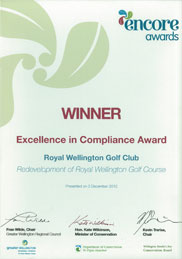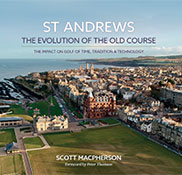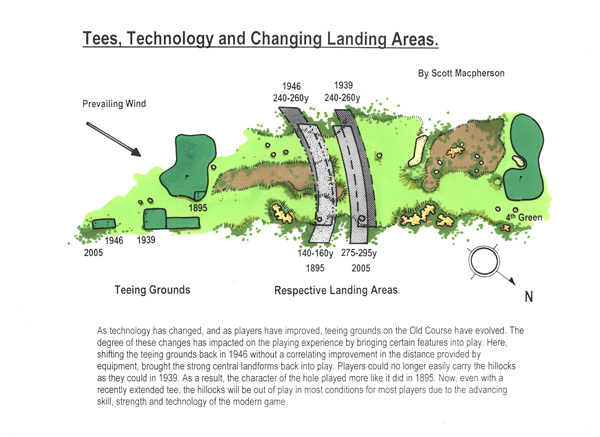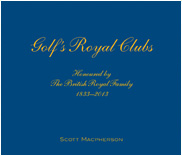GOLF CHAMPIONSHIPS ON SMGD COURSES:
At Close House – Colt Course. Sept 2017. A prestigious European Tour Championship hosted by Lee Westwood.
Broadcast worldwide from Royal Wellington Golf Club, NZ. October 2017. WOW!
The legacy continues.
Co-hosted at the award-winning Millbrook Resort near Queenstown, NZ. 2014 – 2023.
The Evolution of Teeing Grounds
First Published June 2004
The Evolution of Teeing Grounds.
The place from which a player begins each hole has continually evolved. With modern-day pressure pushing tees both further forward and back, how far have ‘teeing grounds’ come?
Figuratively speaking, tees, a word derived from the Gaelic ‘tigh’ meaning house, have come a long way. No longer do golfers ‘tee off’ from a wee mound created from sand taken from the bottom of the previous hole and prepared by their caddie. Indeed, today it may require a golf cart or gondola to get to the next tee.
The Rules best show the gradual movement of tees away from greens. In 1754 the ball had to be teed within one club’s length from the hole last played. By 1858 this distance had increased to not nearer than six and not farther than eight club lengths. In 1875 the ball was not to be teed nearer than eight and farther twelve club lengths, except where a teeing ground was provided. And by 1888 all reference to any distance to the hole within which the ball must be teed disappears from the rules. Instead the rule read- ‘The ball must be teed within the marks laid down by the conservator of the links, which shall be considered the “Teeing Ground.” The balls shall not be teed in advance of such marks nor more than two club lengths behind them.’
The progressive shift of teeing grounds away from greens was the response from the golfing establishment, probably unhappy putting out of divots, to protect the greens. Additionally, with golf’s popularity growing, to increase player safety on the ever more congested links.
Golf course architecture emerged to more positively answer the increased demand for golf. Armed with the teeing ground rule change, those laying out courses now had an opportunity to place tees and greens in locations best suited to their roles. If a green was at the base of a hill, the new tee could be located on top of the hill, removing any blind or uncomfortable shots. With most new courses being laid out inland, and some on land not previously thought suitable for ‘golfing’, this ability to position tees freely was a turning point in course design. It was also the birth of multiple tees.
The value of multiple tees were identified early on. James Braid, five times British Open Champion wrote in his book ‘Advanced Golf’ in 1908, ‘There should be alternate tees, in order that the course be adapted to varying winds and dry weather, when there is more run on the ball. Unless this is done a medium has to be struck in the arrangement of the holes, which seldom makes a really good test in all conditions.”
As tees moved further from the previous hole, and became a separate place nearer the next hole than the last, the ‘back tee’ emerged. It is unknown if what are known as the ‘medal tees’ at St Andrews are older, but it is thought that the special tees to be used on state occasions were first developed at Sandwich in about 1890. Regardless, the championship tees at Sandwich were the earliest example of tees constructed for the purpose of lengthening a course to the extreme limit to test the equipment and players of the day.
Very quickly alternative tees became key considerations on new courses and two and three sets of tees were soon standard. The most modern advent has been the location of ‘forward tees’. Alice Dye revolutionised their precise location in the early 1990’s arguing that male golfers have a choice of tees to play from according to their various abilities, but women don’t. Her studies indicating that about 15% of women golfers are capable of playing a 5,800 (the U.S. National average) yard golf course, but the average woman needs a more manageable 4,800- 5,200 yard course. This shorter yardage is giving women, and indeed senior men and youngsters, “a challenging, yet pleasurable golfing experience”. Her research has led to most new courses having four to five sets of tees.
Teeing grounds are now a complex series of manicured level areas designed to give golfers of all abilities the best challenge and experience. Strategically, the tee is the only time and place an architect can provide a specific view, angle, physical and mental challenge and level of safety for all golfers. Great courses, have great teeing grounds- their correct size, shape, orientation and elevation is paramount.
NB- The tee-peg, first invented in 1889, was originally outlawed in 1776!
AWARDS
 Winner
Winner
Excellence in Compliance Award
Royal Wellington Golf Club
PUBLICATIONS
 St Andrews
St Andrews
The Evolution of the Old Course
by Scott Macpherson
TESTIMONIALS
"RWGC set out to build the best club golf course in New Zealand and to be one that golfers from all around the world will travel to play. We are confident that ambition is being realized."
Peter Cutfield, Chairman, Royal Wellington Golf Club, NZ




